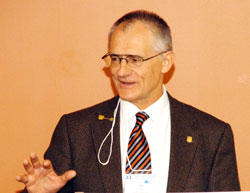Water quality experts get the big picture

Keynote speaker, Jan Oleszkiewicz, addressed European and North American approaches to nutrient removal from waste water. Oleszkiewicz, a professor of environmental engineering at the University of Manitoba, said that municipalities have difficult decisions to make when spending water treatment dollars; they are often not the key polluters of water, but bear the burden of paying for treatment facilities.
photo by Marc Bourcier
“Water doesn’t stop flowing when it changes jurisdictions, so you really need a regional, if not a national, vision of how to deal with water quality issues,” said Building, Civil and Environmen-tal Engineering professor Maria Elektorowicz.
On Nov 3, she chaired the 22nd Eastern Canadian Symposium on Water Quality. Held at Concordia, the event brought together experts from the Atlantic pro-vinces, Quebec and Ontario.
Elektorowicz pointed out that the mix creates an unusual but fertile community. “Scientists are trained to find problems; engineers are trained to solve them. These are fundamentally different approaches and ways of thinking. Here we benefit by being exposed to the other ways.”
The need for multidisciplinary approaches to water quality issues was made clear by keynote speaker Jan Oleszkiewicz, a professor of environmental engineering at the University of Manitoba. He spoke about European and North American approaches to nutrient removal from waste water.
Nutrients, particularly phosphorous and nitrogen, are naturally present in water systems and are key elements in the food chain. In excess, however, the nutrients feed runaway processes like algal blooms and clogging plant growth that can lead to premature eutrophication of lakes and rivers. Contemporary farming, industrial activity and urban living produce vast amounts of nutrients, and so excess is now the norm and municipalities spend millions, if not billions, of dollars on waste water treatment.
Oleszkiewicz said that while the engineering for removing excess nutrients from water is relatively well established, the science of what should be removed and in what proportion is not.
In Europe, regulations require the removal of both phosphorous and nitrogen, with clean water containing “natural” levels in the ratio of 10 to 15 parts nitrogen to one part phosphorous. In parts of Canada, phosphorous is seen as the primary pollutant, and only it is removed. This approach does not seem to stop eutrophication processes, and in fact may feed them.
“We don’t have a handle on the nitrogen-phosphorous ratio,” Oleszkiewicz said. Unbalancing the system may be just as bad as doing nothing at all. He challenged the 100 or so participants to consider this gap as they attended other sessions.
With over 60 oral and poster presentations throughout the day, Elektorowicz said participants would walk away with a big-picture view of water quality issues. “When the issues are complex, this is what is needed,”
She was particularly pleased that the big picture view was going to be shared with many students as well as young alumni. “They are the next generation. This type of experience is invaluable for them.”
In order to encourage graduate student participation at the symposium two awards were presented at an awards ceremony at the event’s close. The Canadian Association of Water Quality Philip H. Jones Award for best oral presentation went to Robert Delatolla from McGill. This year, Concordia offered a certificate for the best poster presentation. It went to Lin Zhao from Concordia.